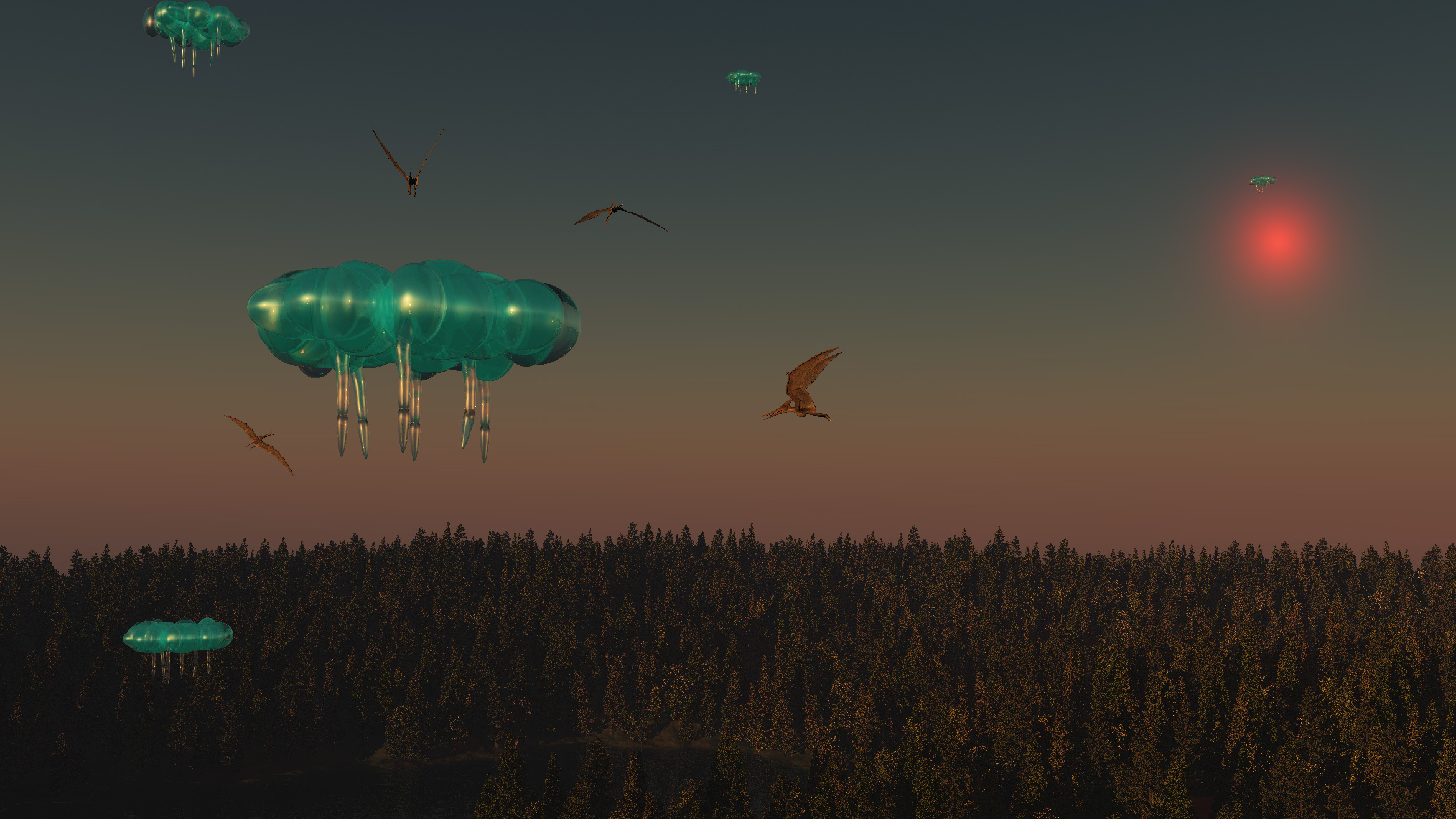Sky Sailors
The sky sailors are a highly unusual species of animal, native to New Cambria, remarkable for progressing through a complex life cycle consisting of three distinct morphologies. The body plans and habitats of the different stages vary so much that early scientists working on the native ecology of New Cambria took a long time to recognise that they were linked and belonged to the same species. Their common name refers only to the most dramatic phase of their life cycle, which is usually considered as the second stage.
Basic Information
Growth Rate & Stages
Sky sailors begin as lavae in the frozen mountains of Friel. The larval stage looks like a small white and grey slug and varies in length between around two centimetres up to twenty at full maturity, a growth period which is believed to take anything from fifteen to twenty New Cambrian years. In the larval stage, they feed on lichens, mosses and frost algae and build a resevoir of chemical elements which are important for their next metamorphosis. Larval sky sailors do not breed but they can sometimes reproduce asexually by subdivision, although this is thought to be a rare process.
When a larva reaches a sufficient level of maturity it joins with others at certain traditional sites on the upper slopes of Mt Grimthorne, at the start of the autumn wind season. Here the individuals meld by their hundreds and thousands, creating the giant sky sailor form which is their best known aspect. The metamorphosis is a complete dissolving of the original bodies, rather like the earthly transformation of a caterpillar to a butterfly except that here many components become the ingredients for one Sky Sailor. It takes at least ten days to complete the process. As a sky sailor, there is a chemical isolation reaction which generates hydrogen, contained in a set of thin but tough membranous bags. Below these balloons, dangle a series of more complex oval chambers which terminate in a delivery tube. These are known as the birthing canals.
Once the sky sailor has achieved sufficient buoyancy it awaits a favourable southbound wind and cuts loose to drift from the pole to the tropics. If all goes well, the sailor will arrive at the equator, perhaps even in the region of the Azure Isles. Here it will deposit a rain of sprat like fish which gestate in egg sacs during the flight. These are of mixed sex and are known locally as silver fins, a name which they acquired long before their connection to the sky sailors was understood.
The silver fins are the breeding stage of the life cycle, but this does not happen until the fish reach sexual maturity, a process which can take another five years in the warm tropical waters. Pregnant female silver fins will eventually swim to the Cap and make their way up the long rugged fjord known as the gash, which brings them closest to the pole. Their young will be the larval form and will swim to shore and migrate inland. The mothers, having birthed the next generation, sometimes die but often survive to swim back south where they may reproduce again and repeat the process.
Ecology and Habitats
In the larval stage, sky sailors live a relatively untroubled life on Friel. There are no known natural predators and most can expect to eventually reach maturity, although growth is constrained by the relatively poor food sources and the low temperatures.
As fully developed sky sailors, their only purpose is to deliver the silver fins to the tropical oceans and they do not eat. They have to contend with the harpies, a species of fearsome aerial hunters which nest on the twin islands of Calgary's Tears. This lies in the migration path and since the sailors can do little more than drift with the wind they are vulnerable to being torn apart and consumed for their proteins.
As fish, the third stage of their cycle eats plants and small sea animals but is itself vulnerable to larger ocean predators and more recently to human fishing. Humans cannot eat the silver fish because of their incompatible amino acid proteins, but they are swept up in the nets of boats designed to harvest introduced earth fish.
The cover image, shows a group of sky sailors crossing the perilous lands of the West Tear as Idris sets with the red star Pendragon casting a baleful glow over the scene. A flock of harpies has selected one of the sailors to attack. There is little that the sailor will
be able to do to defend itself and the species relies on numbers to survive predation.
Conservation Status
Sky sailors are considered to be under threat from human fishing in the Azure Isles and in recent years they also seem to be strangely more vulnerable to predation by harpies, their ancient enemy. The culling of harpies on Calgary's Tears has been suggested as a way to aid species survival and there have been some efforts in this direction though these have been desultory at best.
Geographic Distribution



Comments